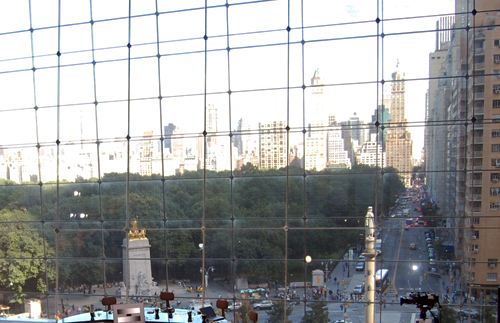
There was a deluge at dawn on Friday, canceling many trains and tempting people to stay at home, in spite of their commitment to arrive at Jazz at Lincoln Center by 9:00 am for the start of the WHY DESIGN NOW? Solving Global Challenges Conference. Luckily, the event was streamed live, both on CooperHewitt.org and on Core77, so those stranded by the weather could participate and join in via Twitter. During the day the online audience grew to over two thousand participants and the tweets flowed fast. The conference was built around the theme of our current Triennial show, answering the question, “Why Design Now?” with a rich selection of presentations and panels.

Beth Comstock, Senior Vice President and CMO of GE, extended GE’s sponsorship of the Triennial to include the event. She welcomed the audience to the Jazz at Lincoln Center Allen auditorium, and tag teamed with me to introduce people throughout the day. Thanks Beth! The huge window wall of the Allen room gives a view down the Southern edge of Central Park, softened by a tinted scrim so that you can easily see the jumbo flat screens showing slides and videos to illustrate the presentations.
Richard Saul Wurman, creator of the TED Conferences and prolific author/publisher, started us off with a presentation that challenged preconceptions and opened our minds to fresh ways of thinking, preparing us to resist the ever-increasing flow of information that threatens to drown our sensibilities, suggesting that we should respond to overload with the fresh faced innocence of ignorance. This led nicely into the discussion of data visualization, whereby design can make at least some sense of vast information fields by visualizing macro structures and trends.
The themes that recurred during the day revolved around energy, health and design processes. A highlight for me was when Elizabeth Scharpf, Founder and Chief Instigating Officer of SHE (Sustainable Health Enterprises), told a story about making more African girls attend school regularly by providing the equivalent of Tampax, locally made from banana fibers. You can watch the video on Youtube.
Another fascinating example was when Timothy Prestero, Co-Founder of Design that Matters, told the story of developing an incubator for premature babies in Africa, describing the impotence of many examples of donated equipment from leading edge companies and organizations, having found examples of second hand equipment lying idle for want of replacement parts, or because nobody local knew how to use them. He also observed that there was a thriving industry in servicing second hand cars, with lots of skilled mechanics, and parts supply organizations with global reach. He set about designing an incubator based on car parts, with head lamps as heating elements and electrical harnesses and fans from cars, so that they can be easily replaced or serviced.
